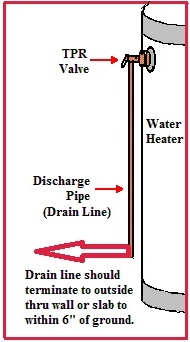The Temperature and Pressure Relief (TPR) valve on the water heater is a safety device that is designed to prevent the water in the tank from exceeding 210 degrees F and prevent the water pressure in the tank from exceeding 150 PSI (pounds per square inch). This safety valve releases water (and thus relieves pressure) if either the temperature or pressure in the tank gets too high. These valves are very important. That’s why all water heater tanks must have a temperature and pressure relief valve installed, otherwise the water heater could simply blow up.  This Arizona home as seen in the photo had the water heater explode and shoot thru the roof like a missile. Missile landing was down the street.Water heaters can become bombs if the pressure gets too high and these valves fail to work. If the water reaches a temperature of 210°F (before superheating occurs) or the water pressure exceeds 150 psi, the valve will open and release the overheated water. This will allow cold water to enter, lowering the temperature of the water in the tank and consequently the water pressure. The valve will remain open as long as the temperature or pressure exceeds the preset limit. The valve must be located on the tank at the top or on the side near the top, where the water is usually the hottest. TPR valves are not usually included with the water heater, so be sure that the TPR valve matches the heat rating (BTU rating) of the water heater.
This Arizona home as seen in the photo had the water heater explode and shoot thru the roof like a missile. Missile landing was down the street.Water heaters can become bombs if the pressure gets too high and these valves fail to work. If the water reaches a temperature of 210°F (before superheating occurs) or the water pressure exceeds 150 psi, the valve will open and release the overheated water. This will allow cold water to enter, lowering the temperature of the water in the tank and consequently the water pressure. The valve will remain open as long as the temperature or pressure exceeds the preset limit. The valve must be located on the tank at the top or on the side near the top, where the water is usually the hottest. TPR valves are not usually included with the water heater, so be sure that the TPR valve matches the heat rating (BTU rating) of the water heater.  A drain line (discharge pipe) must be attached to all TPR valves. The TPRV drain line must be made of a material that’s rated for both high temperature and pressure. This includes most copper, galvanized or stainless steel, cast iron and CPVC (chlorinated poly vinyl chloride). Regular PVC cannot be used. The pipe size of the drain line must match the opening size of the TPR valve which is most commonly ¾ inch and the drain line may not be reduced along its run or may not be tied into any other drain lines including the homes waste drainage line. The drain line cannot be terminated into the water heater overflow pan. It should be terminated to the outside through the slab or walls to within 6” of the ground so as to avoid the possibility of scalding. The discharge location should be readily observable and not located where it could possibly cause property or structural damage. The termination end of the TPRV drain line cannot be threaded or have a fitting which permits plugging or capping.
A drain line (discharge pipe) must be attached to all TPR valves. The TPRV drain line must be made of a material that’s rated for both high temperature and pressure. This includes most copper, galvanized or stainless steel, cast iron and CPVC (chlorinated poly vinyl chloride). Regular PVC cannot be used. The pipe size of the drain line must match the opening size of the TPR valve which is most commonly ¾ inch and the drain line may not be reduced along its run or may not be tied into any other drain lines including the homes waste drainage line. The drain line cannot be terminated into the water heater overflow pan. It should be terminated to the outside through the slab or walls to within 6” of the ground so as to avoid the possibility of scalding. The discharge location should be readily observable and not located where it could possibly cause property or structural damage. The termination end of the TPRV drain line cannot be threaded or have a fitting which permits plugging or capping.
As TPR valves get older they sometimes begin to leak. They tend to weaken over time and also after releasing small amounts of water over time it can build up deposits in the valve that will begin to interfere with it closing. Sometimes particles from the tank get stuck in it holding the valve partially open. The TPR valve on your water heater should be monitored to see when replacement is needed. There is a lever on the TPR valve that lets you manually open it. It is highly recommended to open this periodically to make sure that the Temperature and Pressure Relief Valve and its drain line is functioning and draining properly.
 This Arizona home as seen in the photo had the water heater explode and shoot thru the roof like a missile. Missile landing was down the street.Water heaters can become bombs if the pressure gets too high and these valves fail to work. If the water reaches a temperature of 210°F (before superheating occurs) or the water pressure exceeds 150 psi, the valve will open and release the overheated water. This will allow cold water to enter, lowering the temperature of the water in the tank and consequently the water pressure. The valve will remain open as long as the temperature or pressure exceeds the preset limit. The valve must be located on the tank at the top or on the side near the top, where the water is usually the hottest. TPR valves are not usually included with the water heater, so be sure that the TPR valve matches the heat rating (BTU rating) of the water heater.
This Arizona home as seen in the photo had the water heater explode and shoot thru the roof like a missile. Missile landing was down the street.Water heaters can become bombs if the pressure gets too high and these valves fail to work. If the water reaches a temperature of 210°F (before superheating occurs) or the water pressure exceeds 150 psi, the valve will open and release the overheated water. This will allow cold water to enter, lowering the temperature of the water in the tank and consequently the water pressure. The valve will remain open as long as the temperature or pressure exceeds the preset limit. The valve must be located on the tank at the top or on the side near the top, where the water is usually the hottest. TPR valves are not usually included with the water heater, so be sure that the TPR valve matches the heat rating (BTU rating) of the water heater.  A drain line (discharge pipe) must be attached to all TPR valves. The TPRV drain line must be made of a material that’s rated for both high temperature and pressure. This includes most copper, galvanized or stainless steel, cast iron and CPVC (chlorinated poly vinyl chloride). Regular PVC cannot be used. The pipe size of the drain line must match the opening size of the TPR valve which is most commonly ¾ inch and the drain line may not be reduced along its run or may not be tied into any other drain lines including the homes waste drainage line. The drain line cannot be terminated into the water heater overflow pan. It should be terminated to the outside through the slab or walls to within 6” of the ground so as to avoid the possibility of scalding. The discharge location should be readily observable and not located where it could possibly cause property or structural damage. The termination end of the TPRV drain line cannot be threaded or have a fitting which permits plugging or capping.
A drain line (discharge pipe) must be attached to all TPR valves. The TPRV drain line must be made of a material that’s rated for both high temperature and pressure. This includes most copper, galvanized or stainless steel, cast iron and CPVC (chlorinated poly vinyl chloride). Regular PVC cannot be used. The pipe size of the drain line must match the opening size of the TPR valve which is most commonly ¾ inch and the drain line may not be reduced along its run or may not be tied into any other drain lines including the homes waste drainage line. The drain line cannot be terminated into the water heater overflow pan. It should be terminated to the outside through the slab or walls to within 6” of the ground so as to avoid the possibility of scalding. The discharge location should be readily observable and not located where it could possibly cause property or structural damage. The termination end of the TPRV drain line cannot be threaded or have a fitting which permits plugging or capping.As TPR valves get older they sometimes begin to leak. They tend to weaken over time and also after releasing small amounts of water over time it can build up deposits in the valve that will begin to interfere with it closing. Sometimes particles from the tank get stuck in it holding the valve partially open. The TPR valve on your water heater should be monitored to see when replacement is needed. There is a lever on the TPR valve that lets you manually open it. It is highly recommended to open this periodically to make sure that the Temperature and Pressure Relief Valve and its drain line is functioning and draining properly.
As a Leading Certified AZ home inspection specialist we certainly recommend hiring one of our ASHI certified home inspectors to evaluate the home’s plumbing and other systems prior to purchase for peace of mind.